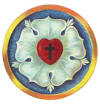Saint Paul Evangelical Lutheran Church of the Unaltered Augsburg Confession
323 1st Ave SW Taylorsville North Carolina
For Jews request a sign, and Greeks seek after wisdom; but we preach Christ crucified, to the Jews a stumbling block and to the Greeks foolishness, but to those who are called, both Jews and Greeks, Christ the power of God and the wisdom of God. 1 Cor 1 22-24
What does UAC stand for?

Unaltered Augsburg Confession (UAC)
Q. What is meant by the Unaltered Augsburg Confession? I have heard of the Augsburg Confession.
A. From the time that the Augsburg Confession was presented by the Lutherans to Charles V until 1540 changes were made that deviated from the original text, changes introduced principally by Philip Melanchthon. Historians differ somewhat on the fine points of the history of this period, but by 1540 when the "altered" (called variata in Latin) version of the Augsburg Confession had been published, Lutherans became increasingly concerned that some of these changes compromised the original confession at Augsburg and were in fact made, as it was supposed, in the interest of closer relations with the Swiss Reformers who had a different understanding (for example) of the Real Presence of Christ in the Lord's Supper. So, this "altered" version of the Augsburg Confession was publicly rejected and commitment to the "Unaltered Augsburg Confession" declared.
This text was converted to ASCII format for Project Wittenberg by Allen Mulvey and is in the public domain. You may freely distribute, copy or print this text. Please direct any comments or suggestions to: Rev. Robert E. Smith of the Walther Library at Concordia Theological Seminary.
E-mail: CFWLibrary@CRF.CUIS.EDU
Luther's Rose

The Luther Rose, also known as the Luther Seal. Martin Luther personally oversaw the creation of this symbol. It provides a beautiful summary of his faith, a faith that is common to all Christians, of every place and every time. Here is how Luther explained the meaning of his seal:
"Grace and peace from the Lord. As you desire to know whether my painted seal, which you sent to me, has hit the mark, I shall answer most amiably and tell you my original thoughts and reason about why my seal is a symbol of my theology. The first should be a black cross in a heart, which retains its natural color, so that I myself would be reminded that faith in the Crucified saves us. For one who believes from the heart will be justified" (Rom. 10:10). Although it is indeed a black cross, which mortifies and which should also cause pain, it leaves the heart in its natural color. It does not corrupt nature, that is, it does not kill but keeps alive. "The just shall live by faith" (Rom. 1:17) but by faith in the crucified. Such a heart should stand in the middle of a white rose, to show that faith gives joy, comfort, and peace. In other words, it places the believer into a white, joyous rose, for this faith does not give peace and joy like the world gives (John 14:27). That is why the rose should be white and not red, for white is the color of the spirits and the angels (cf. Matthew 28:3; John 20:12). Such a rose should stand in a sky-blue field, symbolizing that such joy in spirit and faith is a beginning of the heavenly future joy, which begins already, but is grasped in hope, not yet revealed. And around this field is a golden ring, symbolizing that such blessedness in Heaven lasts forever and has no end. Such blessedness is exquisite, beyond all joy and goods, just as gold is the most valuable, most precious and best metal. This is my compendium theoligae [summary of theology]. I have wanted to show it to you in good friendship, hoping for your appreciation. May Christ, our beloved Lord, be with your spirit until the life hereafter. Amen." *
Service Times:
-
Private Confession and Absolution: 9am Sunday
-
Sunday School Opening: 9:45am
-
Sunday School: 10am
-
Divine Worship: 11am
-
Bible Study Wednesday evening: 7pm
